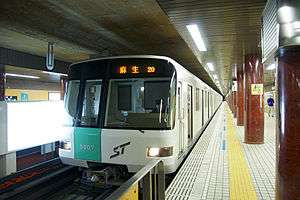Sapporo Municipal Subway 5000 series
| Sapporo Municipal Subway 5000 series | |
|---|---|
 Set 5607 in October 2009 | |
| In service | 1995 – Present |
| Manufacturer | Kawasaki Heavy Industries |
| Replaced | 2000 series, 3000 series |
| Constructed |
1995–1998 2009–2011 |
| Entered service | October 1995 |
| Number built | 120 vehicles (20 sets) |
| Number in service | 120 vehicles (20 sets) |
| Formation | 6 cars per trainset |
| Fleet numbers | 5101-5120 |
| Capacity | 828 |
| Operator(s) | Sapporo Municipal Subway |
| Line(s) served | Namboku Line |
| Specifications | |
| Car body construction | Aluminum |
| Car length | 18,400 mm (60 ft 4 in) |
| Width | 3,080 mm (10 ft 1 in) |
| Height | 3,730 mm (12 ft 3 in) |
| Floor height | 1,330 mm (4 ft 4 in) |
| Doors | 4 pairs per side |
| Maximum speed | 70 km/h (45 mph) |
| Weight | 179.4 tons |
| Traction system | Variable frequency (IGBT) |
| Acceleration | 4.5 km/h/s |
| Deceleration |
4.0 km/h/s (service) 5.0 km/h/s (emergency) |
| Electric system(s) | 750 V DC |
| Current collection method | Third rail collector shoes |
| Bogies |
KW-111 (powered cars) KW-112 (trailer cars) |
| Braking system(s) | Regenerative braking |
| Safety system(s) | ATC |
| Track gauge | (Rubber tire) |
The Sapporo Municipal Subway 5000 series (札幌市交通局5000形) is a DC electric multiple unit (EMU) rubber-tyred metro train type operated by Sapporo Municipal Subway on the Namboku Line in the city of Sapporo, Japan, since October 1995.[1]
Design
The trains are built by Kawasaki Heavy Industries and have aluminum bodies. Each car has four doors per side as opposed to two per side as seen on the older 2000 series and 3000 series cars. The 5000 series cars remain the only cars on the entire subway system with four doors.
The 5000 series use a variable frequency drive as opposed to chopper control on the 3000 series and resistor control on the 2000 series, which helps to reduce power consumption and maintenance costs.[2]
Formations
The 5000 series trains are formed as six-car sets as shown below.
| Car No. | 1 | 2 | 3 | 4 | 5 | 6 |
|---|---|---|---|---|---|---|
| Designation | Tc | M | M | T | M | Tc |
| Numbering | 5100 | 5200 | 5300 | 5400 | 5500 | 5600 |
| Weight (t) | 24.3 | 25.3 | 25.3 | 23.4 | 25.3 | 24.3 |
| Capacity (total/seated) | 128/42 | 143/45 | 143/45 | 143/45 | 143/45 | 128/42 |
Interior
Passenger accommodation consists of longitudinal bench seating throughout, with a wheelchair space in each car. The first 17 sets use LCD destination indicators; the 18th to 20th sets use LCD displays as destination indicators.
 Interior of a 5000 series car in March 2017
Interior of a 5000 series car in March 2017
History
Built in 1995 to combat issues of platform congestion, the first 5000 series set was introduced onto the line in October 1995; a total of 17 sets were introduced from 1995 to 1999, ultimately replacing all of the 2000 series sets in service. Three more sets were introduced from 2009 to 2011 to replace the last remaining 3000 series sets at the time.
References
- ↑ 地下鉄(高速電車)の概要 [Subway (high-speed) overview] (in Japanese). Japan: Sapporo Municipal Subway. Retrieved 15 November 2017.
- ↑ 5000形の車両紹介 [5000 series introduction]. SCSIS (in Japanese). Japan. Retrieved 15 November 2017.
External links
| Wikimedia Commons has media related to Sapporo Municipal Subway 5000 series. |
This article incorporates information from the corresponding article on the Japanese Wikipedia.